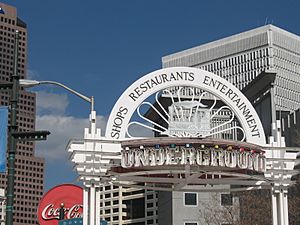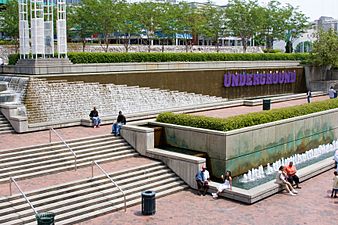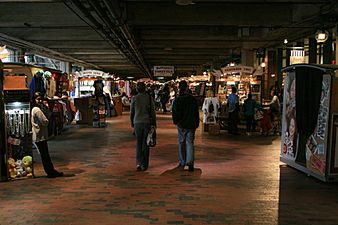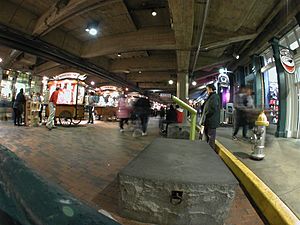Underground Atlanta facts for kids

Entrance to Underground Atlanta, near the corner of Peachtree and Wall
|
|
| Coordinates | 33°45′10″N 84°23′24″W / 33.75274°N 84.39008°W |
|---|---|
| Opening date |
|
| Closing date |
|
| Owner | Billionaires Funding Group |
| Public transit access | Five Points MARTA station |
|
Underground Atlanta Historic District
|
|
| NRHP reference No. | 80001077 |
| Added to NRHP | July 24, 1980 |
Underground Atlanta is a unique shopping and entertainment area in the Five Points neighborhood of downtown Atlanta, Georgia, United States. It's located close to the Five Points MARTA station. This cool spot is currently being updated and improved. It first opened in 1969. The area uses special viaducts, which are like bridges, built over the city's many railroad tracks. These bridges helped make space for cars and people above the original street level.
Contents
Where is Underground Atlanta Located?
Underground Atlanta is built around the historic railroad gulch. This area follows the train tracks. It runs between Forsyth Street and Central Avenue, parallel to Alabama Street.
In 1979, the area was recognized as the Underground Atlanta Historic District. It was added to the National Register of Historic Places. This special district is mainly bordered by Alabama Street, Central Avenue, Peachtree Street, and Martin Luther King, Jr. Drive.
The area is split into four main blocks by Pryor Street and Alabama Street. Both Pryor and Alabama Streets have two levels. These are known as Upper and Lower Alabama and Pryor Streets.
- The north block has Peachtree Fountains Plaza.
- The east block is next to Pryor, Alabama, Central, and Wall streets.
- The south block is near Pryor, Alabama, Central, and MLK streets.
- The west block is bordered by Peachtree, Alabama, Pryor, and MLK streets.
History of Underground Atlanta

The buildings that make up Underground Atlanta were built after the American Civil War. This was a time when Atlanta was growing very fast, between 1866 and 1871. The city's population actually doubled during these years.
In 1869, the Georgia Railroad Freight Depot was finished. It replaced the one that was destroyed during Sherman's March to the Sea in 1864. This train depot is at the entrance of Underground Atlanta. It is the oldest building in downtown Atlanta. The depot originally had three stories, but a fire in 1935 destroyed the top two.
Besides the train station, this busy area had hotels, banks, law offices, and saloons. An electric streetcar was added in 1889. By 1900, the depot was handling 100 trains every day. These trains connected Atlanta to major cities like New York City and Cincinnati.
Raising the Streets
By 1910, there was so much train activity that several iron bridges were built. These bridges helped people and cars cross over the railroad tracks. An architect named Haralson Bleckley suggested covering the tracks completely with a concrete platform in 1909. This platform would have created new boulevards and public spaces. While his full plan wasn't built, Plaza Park was created in 1948. It was later rebuilt as Peachtree Fountains Plaza.
In 1928, the "twin bridges" viaduct was completed. This raised the street level of Pryor, Central, Wall, and Alabama streets by about one and a half stories. A five-block area was completely covered up. This meant the original street levels became hidden. They were like basements for storage.
During this time, many merchants moved their shops to the second floor of their buildings. The original ground floors became storage areas. Since this was during Prohibition, when alcohol was illegal, some of these hidden "basements" became secret places for music and fun. These were known as speakeasys and juke joints. The area was even mentioned in Bessie Smith's 1927 song "Preachin' The Blues."
For the next forty years, as Atlanta grew above ground, the 12-acre underground area was mostly forgotten.
Underground Atlanta as an Entertainment Spot
In the 1960s, the original storefronts were rediscovered. Many old architectural details were still there. These included brickwork, granite arches, marble, and gas street lamps. Two graduates from Georgia Tech, Steven H. Fuller Jr. and Jack R. Patterson, decided to bring "the city beneath the city" back to life. They planned to make it a new shopping and entertainment area.
Their company, Underground Atlanta, Inc., started in 1967. They began to get permission to use the buildings under the viaducts. Construction started in November 1968. A special law was passed in Georgia to make the area a state historic site. The renovation kept the old building fronts mostly the same.

The company spent $10 million to turn the historic area into an entertainment district. On April 8, 1969, "Underground Atlanta" officially opened. It had new restaurants, bars, nightclubs, and music venues in the old shops. At the time, Fulton County was the only county in Georgia that allowed mixed alcoholic drinks. This made Underground Atlanta a popular spot for nightlife.
Some popular places included Dante's Down the Hatch and Muhlenbrink's Saloon. Piano Red, also known as Dr. Feelgood, played music there for many years. There was also a souvenir shop owned by Governor Lester Maddox and a wax museum. With its old-style buildings, Underground Atlanta quickly became a top tourist attraction. It was even compared to Bourbon Street in New Orleans. In 1972, it had 3.5 million visitors and made $17 million in sales. At its busiest, there were over 80 businesses.
However, this popularity only lasted about five years. The legal drinking age in Georgia was lowered from 21 to 19. Other counties also started allowing more places to serve alcohol. This created more competition. The dress code rules were removed, and the area became less safe. Also, the construction of the MARTA East Line starting in 1975 removed part of Underground Atlanta and took away parking.
By 1976, sales were much lower. In 1975, The New York Times reported that the area was struggling. Underground Atlanta Inc. even suggested fencing off the area and charging a small fee to enter.
The Underground Atlanta Historic District was added to the National Register of Historic Places on July 24, 1980. This was the same year that Underground Atlanta closed. Only 26 businesses were left. By February 1982, the area was abandoned again.
Underground Atlanta as a Shopping Mall
Underground Atlanta was mostly empty for much of the 1980s. Some historic buildings were damaged by fires. In 1982, the new mayor, Andrew Young, wanted to reopen Underground Atlanta. He saw it as a way to help downtown Atlanta. A study was done to plan a full redevelopment of Underground and the surrounding blocks.
A new group, Underground Festival Development, Inc. (UFD), was formed in 1985. They planned to oversee the project. The Rouse Company, known for other shopping areas like Faneuil Hall in Boston, was asked to manage the site. The project was delayed for a while due to legal issues.
To make sure the area felt safe, UFD planned new entrances, exits, and lighting. The Rouse Company also put together a security team. Some clubs that were damaged by the MARTA construction received money. They used this money to help rebuild the area a second time.
The reconstruction of Underground Atlanta began after legal approval in 1986. The total renovation cost $142 million. The city of Atlanta paid most of this amount. On June 15, 1989, Underground Atlanta reopened. This time, it was more of a modern shopping mall than just an entertainment district. The new Underground had twice as much retail space. It had 140 businesses, including shops like Sam Goody. Kenny's Alley became the main entertainment area. The whole project covered about 12 acres and had parking for 1,200 cars. This redevelopment won an award for its urban design in 1990.
The renovation also replaced Plaza Park with Peachtree Fountains Plaza. Plaza Park used to have the last peach tree on Peachtree Street. However, 20 new peach trees were planted in nearby Woodruff Park.
Some people felt that the new, cleaner area had lost some of its original charm. One critic said it felt like "Disney World's Main Street."
-
Six Gun Territory No. 4, a 4-4-0 steam locomotive on display at the entrance of the revamped Underground. This locomotive was sold to the Kirby Family Farm in 2017.
The first year of sales was good, with $75 million and 13 million visitors. Developers hoped Underground Atlanta would become a major tourist spot, like Stone Mountain Park and Six Flags Over Georgia. The New Georgia Railroad even ran a vintage train from near Underground Atlanta to Stone Mountain Park until 1993.
In August 1990, the World of Coca-Cola museum opened next to Underground Atlanta. This brought even more tourists. In September 1990, Atlanta was chosen to host the 1996 Summer Olympic games. People gathered at Kenny's Alley to watch the announcement.
However, in April 1992, the area faced challenges from public unrest. A curfew was put in place. Even though many people visited during the 1996 Olympics, Underground Atlanta still struggled financially.
In the late 1990s, Underground Atlanta had shops, restaurants, and nightclubs. In 2004, to try and keep it from closing again, the city allowed bars to stay open later. People could even take their drinks from one bar to another. Despite these efforts, Underground Atlanta had trouble attracting a steady crowd. Eventually, it closed for a second time in 2016.
New Plans for Underground Atlanta
On December 17, 2014, Atlanta's mayor, Kasim Reed, announced that the city was selling Underground Atlanta to a developer called WRS Inc. The developer planned to turn it into a mixed-use development. This would include more shops and restaurants, plus apartments above ground. The sale was completed in March 2017, and the lower level closed to the public on August 13, 2017. Some people were unsure about WRS Inc. because they were known for building suburban strip malls. By January 2020, there weren't many visible changes.
On November 28, 2020, Underground Atlanta was sold again. The new owner is Shaneel Lalani, CEO of Billionaires Funding Group (BFG). Lalani brought in experts to suggest new ideas for the site. Their ideas included more mixed-use development with homes, more shops and places to eat, and reopening outdoor areas. By 2021, BFG had hired companies to create a new master plan. Several new businesses were announced in 2022.





